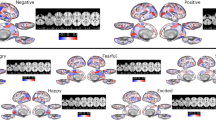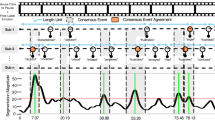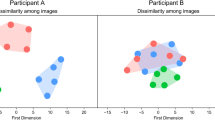Abstract
How do people represent their own and others’ emotional experiences? Contemporary emotion theories and growing evidence suggest that the conceptual representation of emotion plays a central role in how people understand the emotions both they and other people feel1,2,3,4,5,6. Although decades of research indicate that adults typically represent emotion concepts as multidimensional, with valence (positive–negative) and arousal (activating–deactivating) as two primary dimensions7,8,9,10, little is known about how this bidimensional (or circumplex) representation arises11. Here we show that emotion representations develop from a monodimensional focus on valence to a bidimensional focus on both valence and arousal from age 6 to age 25. We investigated potential mechanisms underlying this effect and found that increasing verbal knowledge mediated the development of emotion representation over and above three other potential mediators: fluid reasoning, the general ability to represent non-emotional stimuli bidimensionally and task-related behaviours (for example, using extreme ends of rating scales). These results indicate that verbal development aids the expansion of emotion concept representations (and potentially emotional experiences) from a ‘positive or negative’ dichotomy in childhood to a multidimensional organization in adulthood.
This is a preview of subscription content, access via your institution
Access options
Access Nature and 54 other Nature Portfolio journals
Get Nature+, our best-value online-access subscription
$29.99 / 30 days
cancel any time
Subscribe to this journal
Receive 12 digital issues and online access to articles
$119.00 per year
only $9.92 per issue
Buy this article
- Purchase on Springer Link
- Instant access to full article PDF
Prices may be subject to local taxes which are calculated during checkout




Similar content being viewed by others
References
Barrett, L. F. Solving the emotion paradox: categorization and the experience of emotion. Personal. Soc. Psychol. Rev. 10, 20–46 (2006).
Nook, E. C., Lindquist, K. A. & Zaki, J. A new look at emotion perception: concepts speed and shape facial emotion recognition. Emotion 15, 569–578 (2015).
Satpute, A. B. et al. Emotions in ‘black or white’ or shades of gray? How we think about emotion shapes our perception and neural representation of emotion. Psychol. Sci. 27, 1428–1442 (2016).
Lindquist, K. A. & Barrett, L. F. Constructing emotion: the experience of fear as a conceptual act. Psychol. Sci. 19, 898–903 (2008).
Lindquist, K. A., Satpute, A. B. & Gendron, M. Does language do more than communicate emotion? Curr. Dir. Psychol. Sci. 24, 99–108 (2015).
Widen, S. C., Pochedly, J. T. & Russell, J. A. The development of emotion concepts: a story superiority effect in older children and adolescents. J. Exp. Child Psychol. 131, 186–192 (2015).
Russell, J. A. A circumplex model of affect. J. Pers. Soc. Psychol. 39, 1161–1178 (1980).
Russell, J. A. Core affect and the psychological construction of emotion. Psychol. Rev. 110, 145–172 (2003).
Barrett, L. F. Feelings or words? Understanding the content in self-report ratings of experienced emotion. J. Pers. Soc. Psychol. 87, 266–281 (2004).
Ong, D. C., Zaki, J. & Goodman, N. D. Affective cognition: exploring lay theories of emotion. Cognition 143, 141–162 (2015).
Somerville, L. H. & Mclaughlin, K. A. in The Nature of Emotion: Fundamental Questions 2nd edn (eds Fox, A. S. et al.) (Oxford Univ. Press, New York, NY, in the press).
Adolphs, R. How should neuroscience study emotions? By distinguishing emotion states, concepts, and experiences. Soc. Cogn. Affect. Neurosci. 12, 24–31 (2016).
Kousta, S.-T., Vigliocco, G., Vinson, D. P., Andrews, M. & Del Campo, E. The representation of abstract words: why emotion matters. J. Exp. Psychol. Gen. 140, 14–34 (2011).
Widen, S. C. Children’s interpretation of facial expressions: the long path from valence-based to specific discrete categories. Emot. Rev. 5, 72–77 (2013).
Wintre, M. G. & Vallance, D. D. A developmental sequence in the comprehension of emotions: intensity, multiple emotions, and valence. Dev. Psychol. 30, 509–514 (1994).
Larsen, J. T., To, Y. M. & Fireman, G. Children’s understanding and experience of mixed emotions. Psychol. Sci. 18, 186–191 (2007).
Gnepp, J. & Klayman, J. Recognition of uncertainty in emotional inferences: Reasoning about emotionally equivocal situations. Dev. Psychol. 28, 145–158 (1992).
Pons, F., Harris, P. L. & de Rosnay, M. Emotion comprehension between 3 and 11 years: developmental periods and hierarchical organization. Eur. J. Dev. Psychol. 1, 127–152 (2004).
Harter, S. & Buddin, B. J. Children’s understanding of the simultaneity of two emotions: a five-stage developmental acquisition sequence. Dev. Psychol. 23, 388–399 (1987).
Russell, J. A. & Ridgeway, D. Dimensions underlying children’s emotion concepts. Dev. Psychol. 19, 795–804 (1983).
Bullock, M. & Russell, J. A. Preschool children’s interpretation of facial expressions of emotion. Int. J. Behav. Dev. 7, 193–214 (1984).
Russell, J. A. & Bullock, M. Multidimensional scaling of emotional facial expressions: similarity from preschoolers to adults. J. Pers. Soc. Psychol. 48, 1290–1298 (1985).
Sharp, C., van Goozen, S. & Goodyer, I. Children’s subjective emotional reactivity to affective pictures: gender differences and their antisocial correlates in an unselected sample of 7-11-year-olds. J. Child Psychol. Psychiatry 47, 143–150 (2006).
Kashdan, T. B., Barrett, L. F. & McKnight, P. E. Unpacking emotion differentiation: transforming unpleasant experience by perceiving distinctions in negativity. Curr. Dir. Psychol. Sci. 24, 10–16 (2015).
Salmon, K., O’Kearney, R., Reese, E. & Fortune, C.-A. The role of language skill in child psychopathology: implications for intervention in the early years. Clin. Child Fam. Psychol. Rev. 19, 352–367 (2016).
Farkas, G. & Beron, K. The detailed age trajectory of oral vocabulary knowledge: differences by class and race. Soc. Sci. Res. 33, 464–497 (2004).
Baron-Cohen, S., Golan, O., Wheelwright, S., Granader, Y. & Hill, J. Emotion word comprehension from 4 to 16 years old: a developmental survey. Front. Evol. Neurosci. 2, 109 (2010).
Lupyan, G. in The Psychology of Learning and Motivation Vol. 57 (ed. Ross, B. H.) 255–297 (Academic Press, London, 2012).
Fugate, J. M. B., Gouzoules, H. & Barrett, L. F. Reading chimpanzee faces: evidence for the role of verbal labels in categorical perception of emotion. Emotion 10, 544–554 (2010).
Beck, L., Kumschick, I. R., Eid, M. & Klann-Delius, G. Relationship between language competence and emotional competence in middle childhood. Emotion 12, 503–514 (2012).
De Stasio, S., Fiorilli, C. & Di Chiacchio, C. Effects of verbal ability and fluid intelligence on children’s emotion understanding. Int. J. Psychol. 49, 409–414 (2014).
de Rosnay, M., Pons, F., Harris, P. L. & Morrell, J. M. B. A lag between understanding false belief and emotion attribution in young children: relationships with linguistic ability and mothers’ mental-state language. Br. J. Dev. Psychol. 22, 197–218 (2004).
Cattell, R. B. Intelligence: Its Structure, Growth and Action (North-Holland, Amsterdam, 1987).
Piaget, J. The Child’s Conception of Number (Norton, New York, NY, 1952).
Howard, D. V. & Howard, J. H. A multidimensional scaling analysis of the development of animal names. Dev. Psychol. 13, 108–113 (1977).
Chambers, C. T. & Johnston, C. Developmental differences in children’s use of rating scales. J. Pediatr. Psychol. 27, 27–36 (2002).
Suvak, M. K. et al. Emotional granularity and borderline personality disorder. J. Abnorm. Psychol. 120, 414–426 (2011).
Carey, S. The Origin of Concepts (Oxford Univ. Press, New York, NY, 2011).
Sprung, M., Münch, H. M., Harris, P. L., Ebesutani, C. & Hofmann, S. G. Children’s emotion understanding: a meta-analysis of training studies. Dev. Rev. 37, 41–65 (2015).
Van Bergen, P. & Salmon, K. The association between parent–child reminiscing and children’s emotion knowledge. NZ J. Psychol. 39, 51–56 (2010).
Wechsler, D. Wechsler Abbreviated Scale of Intelligence: Second Edition Manual (Pearson, Bloomington, MN, 2011).
Ekman, P. & Friesen, W. V. Constants across cultures in the face and emotion. J. Pers. Soc. Psychol. 17, 124–129 (1971).
Carroll, J. D. & Chang, J.-J. Analysis of individual differences in multidimensional scaling via an n-way generalization of ‘Eckart–Young’ decomposition. Psychometrika 35, 283–319 (1970).
De Leeuw, J. & Mair, P. Multidimensional scaling using majorization: SMACOF in R. J. Stat. Softw. 31, 1–30 (2009).
Mair, P., Borg, I. & Rusch, T. Goodness-of-fit assessment in multidimensional scaling and unfolding. Multivariate Behav. Res. 51, 772–789 (2016).
Erbas, Y., Ceulemans, E., Boonen, J., Noens, I. & Kuppens, P. Emotion differentiation in autism spectrum disorder. Res. Autism Spectr. Disord. 7, 1221–1227 (2013).
Potter, T. C. S., Bryce, N. V. & Hartley, C. A. Cognitive components underpinning the development of model-based learning. Dev. Cogn. Neurosci. 25, 272–280 (2017).
Venables, W. N. & Ripley, B. D. Modern Applied Statistics with R (Springer, New York, NY, 2002).
Davison, A. C. & Hinkley, D. V. Bootstrap Methods and Their Applications (Cambridge Univ. Press, Cambridge, 1997).
Bennett, D. S., Bendersky, M. & Lewis, M. Antecedents of emotion knowledge: predictors of individual differences in young children. Cogn. Emot. 19, 375–396 (2005).
Nook, E. C., Sasse, S. F., Lambert, H. K., McLaughlin, K. A. & Somerville, L. H. Increasing verbal knowledge mediates development of multidimensional emotion representations: online repository. Open Science Framework https://doi.org/10.17605/OSF.IO/XE4PS (2017).
Acknowledgements
We thank C. R. M. Bolden, A. Dews, E. Fearey, M. Garrad, T. Gogue-Garcia, K. Kent, A. Sareen, M. Sirak, T. Stacy, C. Stavish and C. Uhrig for assistance with data collection; J. Snedeker for discussion; and P. Mair and members of Harvard University’s Institute for Quantitative Social Science for guidance on statistical analyses. This work was supported by a Harvard University seed grant to L.H.S., a National Institutes of Mental Health grant to K.A.M. (R01-MH103291), and a National Science Foundation Graduate Research Fellowship (grant DGE1144152) to E.C.N. Funders had no role in study design, data collection and analysis, decision to publish, or preparation of the manuscript.
Author information
Authors and Affiliations
Contributions
Authors collaboratively developed the study design. E.C.N. programmed computer tasks. E.C.N., S.F.S. and H.K.L. collected data. E.C.N. analysed data. E.C.N. and L.H.S. interpreted results. E.C.N. drafted the manuscript, and all other authors provided critical revisions. All authors approved the final version of the manuscript.
Corresponding author
Ethics declarations
Competing interests
The authors declare no competing interests.
Additional information
Publisher’s note: Springer Nature remains neutral with regard to jurisdictional claims in published maps and institutional affiliations.
Electronic supplementary material
Supplementary Information
Supplementary Notes, Supplementary Figures 1–4, Supplementary References
Rights and permissions
About this article
Cite this article
Nook, E.C., Sasse, S.F., Lambert, H.K. et al. Increasing verbal knowledge mediates development of multidimensional emotion representations. Nat Hum Behav 1, 881–889 (2017). https://doi.org/10.1038/s41562-017-0238-7
Received:
Accepted:
Published:
Issue Date:
DOI: https://doi.org/10.1038/s41562-017-0238-7
This article is cited by
-
US and Japanese adolescents’ emotions across time: variation by valence and arousal
Current Psychology (2024)
-
The acquisition of emotion-laden words from childhood to adolescence
Current Psychology (2023)
-
Emotional Granularity is Associated with Daily Experiential Diversity
Affective Science (2023)
-
The cultural evolution of emotion
Nature Reviews Psychology (2022)
-
Similarities and differences in concepts of mental life among adults and children in five cultures
Nature Human Behaviour (2021)



